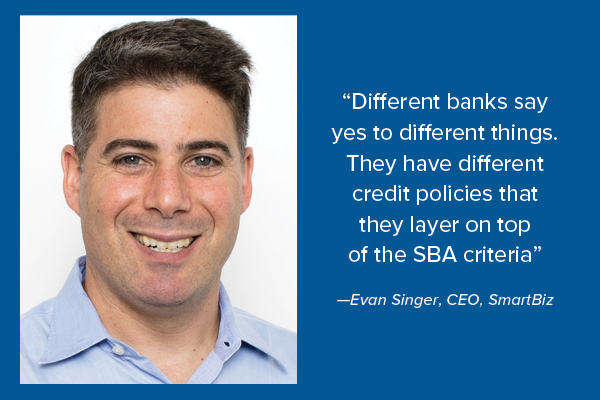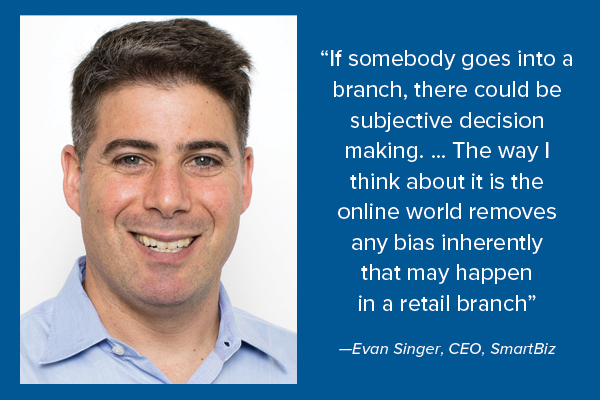SBA enabler on sprouting more loans
Retail marketplace lending platform morphed into business credit mechanism
- |
- Written by Bill Streeter
 SmartBiz CEO Evan Singer talks about why and how his fintech firm works with banks in the SBA 7(a) loan market.
SmartBiz CEO Evan Singer talks about why and how his fintech firm works with banks in the SBA 7(a) loan market.
When your largest client asks for a favor, you tend to do everything you can to help. For fintech company SmartBiz, that led to completely changing its business model.
The San Francisco-based company began life as an online consumer lender in 2010. However, three years in, the company switched gears to focus on small business lending. This change came after Metro PCS, the wireless phone company since acquired by T-Mobile, asked SmartBiz if it could finance some of its dealers.
CEO Evan Singer realized the company’s origination software could be adapted to the smaller end of the Small Business Administration 7(a) loan market. He says most banks had lost interest in this market because of the cost of originating and handling these small loans.
Thus began a transition that culminated in SmartBiz selling off its consumer lending business. In place of that, SmartBiz built a bank-centric marketplace—an “ecosystem” in Singer’s words—in which SmartBiz refers qualified SBA loan applications to a network of banks. Currently the company works with five banks in the U.S. Three of these he mentioned in an interview with Banking Exchange were: Salt Lake City-based Celtic Bank, Tampa-based First Home Bank, and Five Star Bank, Sacramento.
In brief, SmartBiz makes it simple for small businesses to apply for an SBA loan online or by mobile device. The company runs the applications through an artificial intelligence filter, and, for those that pass, offers them to its partner banks. The banks license origination software from SmartBiz and make the final decision. The software incorporates each bank’s unique underwriting standards.
SBA 7(a) loans of less than $350,000 comprise the majority of loans arranged by SmartBiz, says Singer, although it has a program for larger loans, as well. In 2016, SmartBiz arranged $225 million in originations, making it the largest program for traditional SBA 7(a) loans under $350,000, Singer says.
The following is an edited recounting of an interview with Singer.
Banking Exchange: Can you explain further why you made the switch from the consumer loan business to the small business loan market?
Singer: We were helping retail customers of Metro PCS to finance their phone bills or their phones. Metro PCS had thousands of independent dealers and stores that sold their products and services, and the company asked if we could help finance their stores—to purchase inventory, for working capital, or potentially to buy their building.
The stores typically needed $50,000 to $200,000, but were having a hard time obtaining financing at a decent rate. When we dove deeper, we found that starting in 2008 with the recession, many banks pulled out of the smaller end of the small business lending market.
Actually pretty much all of them did.
They left for many reasons. The main one, though, is that it cost them just as much to originate a $200,000 loan as it did a $2 million loan.

Much of the void was filled by some expensive online players including OnDeck and CAN Capital. But the Metro PCS stores had no appetite to borrow expensive money, even if it was easy to get. And so they were in a tough spot.
We felt we could convert our existing base technology for use in small business lending. The concept, and what we have been working on since, is three-fold.
• First, it was key that we be able to tap into banks with their low cost of capital to provide well-priced loans to small business. But we had to make it economically feasible for the banks to make these loans, so we developed software that enables banks to auto-underwrite and auto-originate SBA loans quickly and easily.
• Second, small businesses want it to be easy to apply for a loan. SBA loans are typically very difficult to get—they can take months and months. So we made the process easier, automating a lot of the more difficult work, and put it online.
• Third, one of the most important things for a small business is get to a “yes.” So we created the first online SBA loan marketplace, in which we have multiple banks [currently five] looking at the loans.
Different banks say yes to different things. They have different credit policies that they layer on top of the SBA criteria. By working with multiple banks, we can drive up approval rates.
BE: Do you concentrate on SBA 7(a) loans?
Singer: Yes. We’ve been focused on 7(a) loans in the sub $350,000 market for working capital. About six months ago we launched commercial real estate loans up to $5 million on the platform—also 7(a) loans.
The key difference between 7(a) and 504 loans [the other main SBA loan type] is, with the 7(a) loan, the bank makes the entire loan. The loans typically have a 25-year term with a 25-year amortization period.
Things work differently with 504 loans. With that type, the loan is handled in part by the bank and in part—actually 40%—by a CDC, a community development corporation.
So there are actually two different loans. The bank’s loan typically has a shorter term. The amortization period is the same at 25 years, but it may only have a five-year term or a ten-year term. And then it has to be refinanced when that balloon payment comes due.
There are advantages for the borrowers in both situations. The 504’s are a bit more complex. But they’re both good decent loans for a small business that wants to buy or to refinance property.
BE: Do banks typically prefer to work with 7(a) loans?
Singer: It depends on the bank and on what they’re going after. The 504 loans can be made in larger amounts, so if a bank wants to do a $10 million deal, and its wishes to use a government guarantee program, they would use a 504. If they’re going to do a smaller deal, they might use the 7(a) program, which only goes up to $5 million. But most of the SBA loan market is 7(a).
BE: How is the underwriting handled working with the banks in your marketplace?
Singer: Unlike a traditional fintech company, which brings its underwriting model to a bank and says “Use this,” we do the opposite. We take the bank’s underwriting and digitize it. So we customize the underwriting software that each bank uses. That way we can refer the right borrower to the right bank.
Our bank partners constantly tweak their underwriting, either to say “yes” more often to certain credits, or to dial back a particular industry code. We’re very data intensive and we look to collaborate with our banks. But at the end of the day it’s their decision on the underwriting.
BE: So, are we talking about fully automated underwriting?
Singer: Actually, it’s a balance between software and human beings.
The banks are going to have a credit presented to them online to look at, but there’s a human being that’s going to say “Yes” or “No” at the end of the day.
The regulators wouldn’t be happy if it were fully automated. These are $250,000 loans, after all; a little bit different from approving a credit card with a $10,000 limit.
BE: Can you comment on loan quality for the loans you arrange overall?
Singer: Here’s how I’d quantify it: We are either meeting or below [better] than the SBA averages from the chargeoff standpoint for the portfolio. One might think that the smaller loans would not perform as well. That’s not what we’re seeing in the market.
BE: What percentage of applications that come into your system don’t make the cut?
Singer: I don’t think we’ve published anything on that. [SmartBiz is a private company.] It would be interesting for a new bank to note, however, that a little over 90% of what we refer to our bank partners they fund.
So we’re able to do a very good job at understanding what credits will fit their “credit box,” and then making sure they’re seeing those credits. That’s much, much higher than anyone in the industry. And getting that type of approval rate obviously makes the banks more efficient.
Obviously we don’t refer everything we get to our banks. But as I said earlier, if a business comes to us, and it isn’t SBA loan ready, we will help them get ready. Through a combination of AI [artificial intelligence software] and machine learning [software] that we’ve built into our system, we’ll help a small business identify what they need to do to improve. [Editor’s note: For more about artificial intelligence, see our new multi-part series, beginning with “Getting up to speed with AI.”]
BE: In general, how do terms and rates in your network compare with others in the online marketplace?
Singer: All of our loans under $350,000 have a ten-year term. Most of the other players in the market—OnDeck or Funding Circle, for instance—are going to have somewhere between a one- and five-year term—most typically it’s two or three years, and at much higher cost. Our average APR is between 7% and 8%—prime plus 275 [basis points], compared with other online marketplace lenders where the average APR is as much as 44%.
So, if somebody needs $100,000, they’ll get $25,000 with a lot of the alternative lenders online. One of the reasons for that pattern is that to service that debt, the monthly payment is going to be so high that the small business wouldn’t be able to afford the monthly payment on a $100,000 loan, but it could afford the monthly payment on a $25,000 loan.
For us a $100,000 loan has about a $1,100 a month monthly payment. With one of the other alternative guys in the market it’s going to be somewhere between—if they’re lucky—$2,000 to $3,000 a month. And if they’re unlucky, between $12,000 to $13,000 dollars a month with daily or weekly payments. That’s an order of magnitude difference.
BE: Do your partner banks continue to do SBA lending on their own?
Singer: Oh sure. All of our banks have their own SBA loan business; we are a portion of that. We are a referral source to the banks. We are also a referral agent for small businesses.
BE: Are there any geographic restrictions on your partner banks?
Singer: No, they tell us what geographies they want to lend to.
Some will work in all 50 states. One bank we just announced—Five Star Bank, out of Sacramento—started in six western states. They’ve since expanded to all states west of the Mississippi.
So the banks can tell us, “These are the credits we want from an underwriting standpoint, a use-of-proceeds standpoint, an industry standpoint, a geographic standpoint.”
They all have different ideas of what they want to do, and we’re happy to accommodate.
BE: Are you reaching out to other potential bank partners?
Singer: Well, I’m not sure we want to add hundreds of banks. We’re picky and choosy about which bank we’re going to add on the platform. They’ve got to be a PLP [Preferred Lending Partner] with the SBA. Essentially the SBA establishes PLP banks as having delegated authority so they can make a loan decision without sending the file to SBA for approval.
What’s critical is that the bank wants to embrace technology; is focused on SBA lending; and has the mindset at the top where they want to partner with a fintech company.
[Editor’s note: PLP is only for the 7(a) program. According to the SBA, of the 2,045 unique lending institutions that made a 7(a) loan in fiscal year 2016, 735 currently have PLP authority. Also, 95% of 7(a) lenders are depository institutions.]
BE: In an interview with a non-banking publication you commented on your success in the woman-owned business sector. Could you comment on that?
Singer: About a third of our banks’ loans are to woman-owned businesses, which is much higher than the national average.
For SBA loans the average is about 14%. For conventional bank loans it’s about 4%. Interestingly, about a third of all small businesses are woman-owned in this country, so we have similar statistics to the overall market.

BE: What might account for the difference?
Singer: There’s not a lender in the country that’s going to bake in male versus female [bias into their underwriting]. They’re not going to do that. But what might happen is, if somebody goes into a branch, there could be subjective decision making that’s made at a retail level.
The way I think about it is the online world removes any bias inherently that may happen in a retail branch. We also have a process where somebody can apply at night or on the weekends, it’s online. And maybe that combination of bias removed, plus ease and efficiency, enables a third of the loans to go to woman-owned businesses.
BE: What is your sense of the future for the marketplace lending sector—in particular the group of players who don’t use your bank-centric model?
Singer: We’re not able to get to “yes” on every loan, obviously. There is absolutely a market for other marketplace lenders and alternative lenders in this space. Banks have essentially left the smaller end of the market, we’re helping to bring them back. But it’s for a specific subset of customers. And I think that the marketplace lenders and the alternative lenders that are religiously focused on meeting customer needs are going to do well going forward.
That said, the mood at the LendIt U.S. conference [in March 2017] was a little different this year than the go-go days of a year or two ago. There likely will be either consolidation or some changes in the market. We’ll have to see how the next year or two unfolds.
Tagged under Technology, Management, Lines of Business, HowTo, Community Banking, Fintech, Feature, Feature3,













